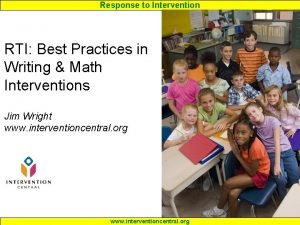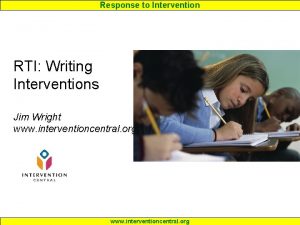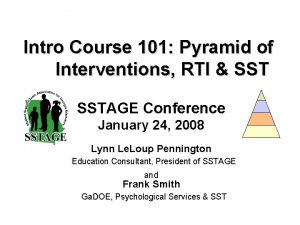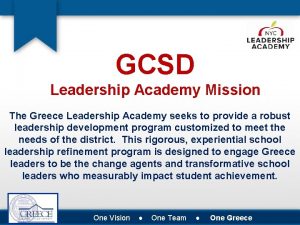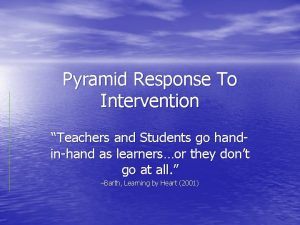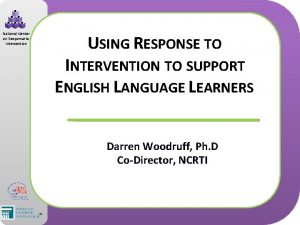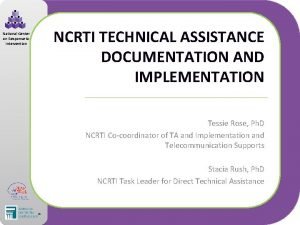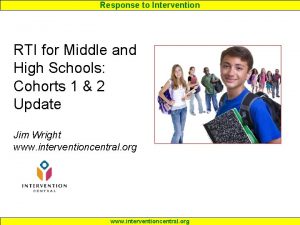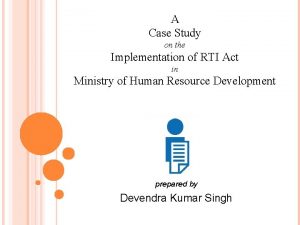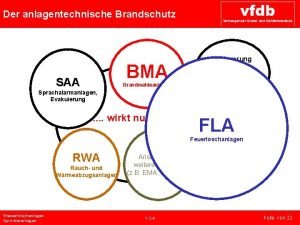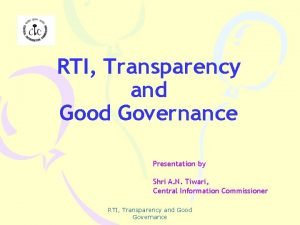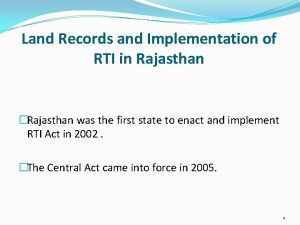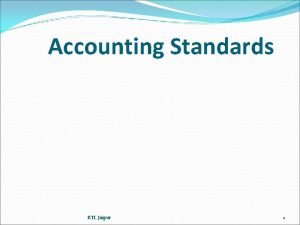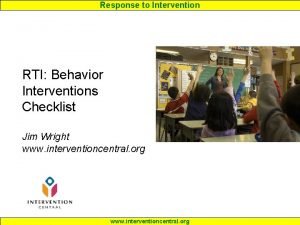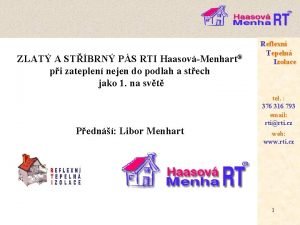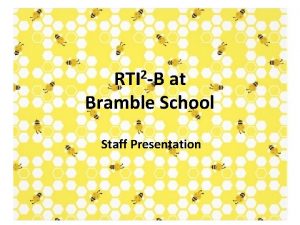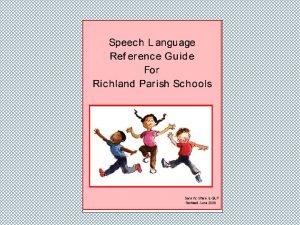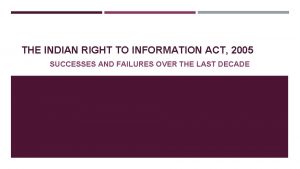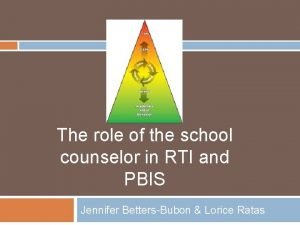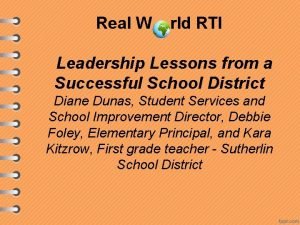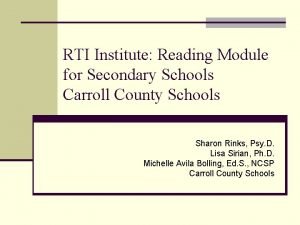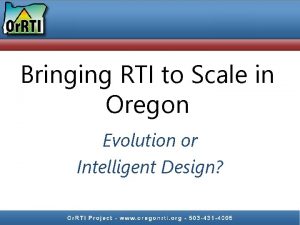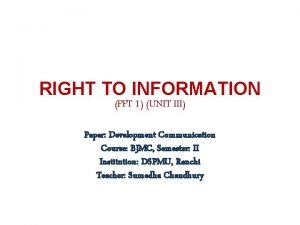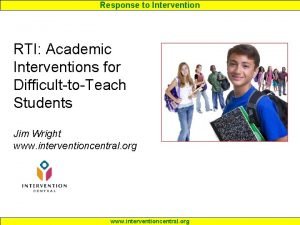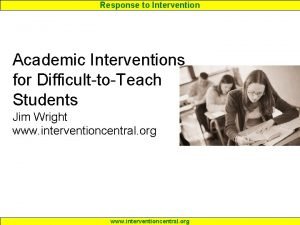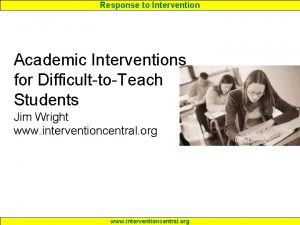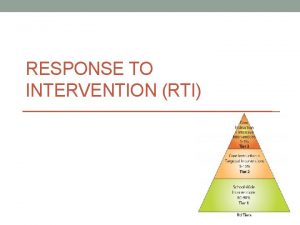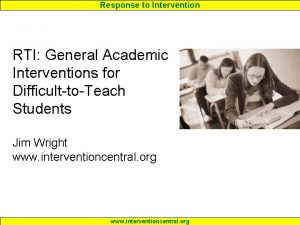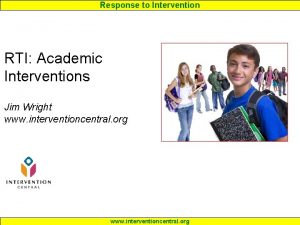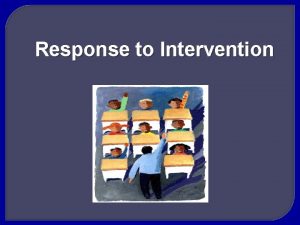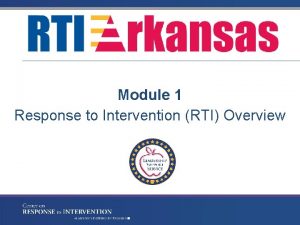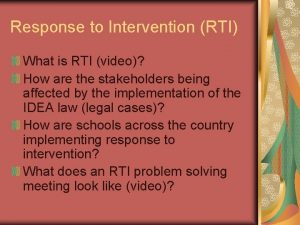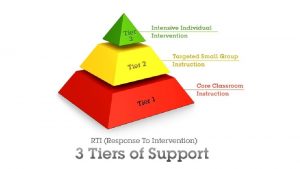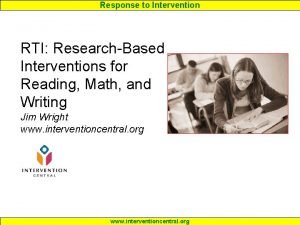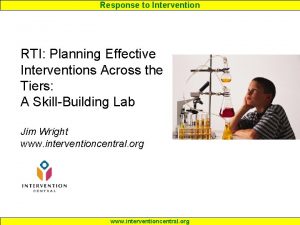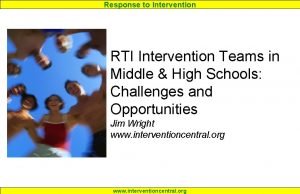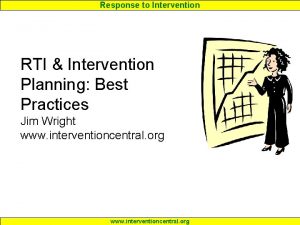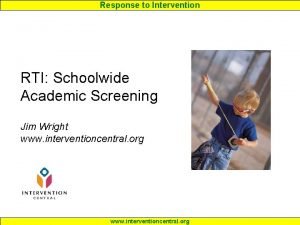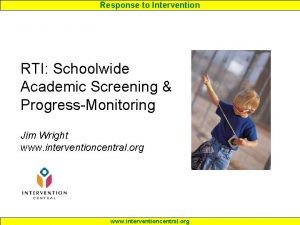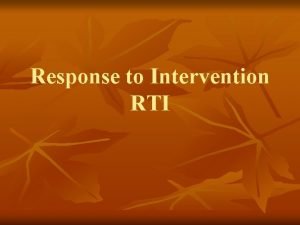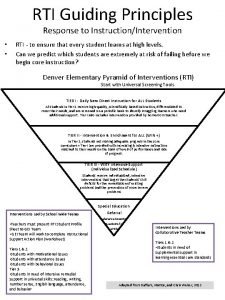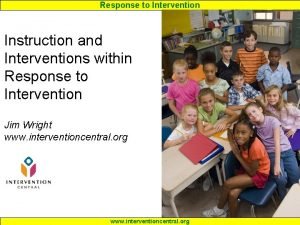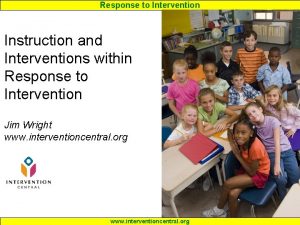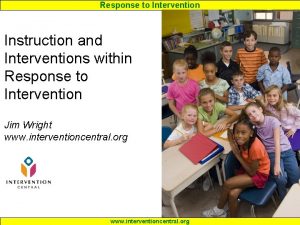Response to Intervention RTI Academic Interventions for DifficulttoTeach









































































- Slides: 73

Response to Intervention RTI: Academic Interventions for Difficult-to-Teach Students Jim Wright www. interventioncentral. org

Response to Intervention Workshop PPTs and Handouts Available at: • http: //www. jimwrightonline. com/CFIHS. php www. interventioncentral. org 2

Response to Intervention Workshop Agenda 1. RTI & Intervention: Key Concepts 2. Math Intervention Example 3. Writing Intervention Example 4. Reading Intervention Example 5. Review of Intervention Websites www. interventioncentral. org

Response to Intervention RTI & Intervention: Key Concepts www. interventioncentral. org

Response to Intervention Essential Elements of Any Academic or Behavioral Intervention (‘Treatment’) Strategy: • Method of delivery (‘Who or what delivers the treatment? ’) Examples include teachers, paraprofessionals, parents, volunteers, computers. • Treatment component (‘What makes the intervention effective? ’) Examples include activation of prior knowledge to help the student to make meaningful connections between ‘known’ and new material; guide practice (e. g. , Paired Reading) to increase reading fluency; www. interventioncentral. org periodic review of material to aid 5

Response to Intervention Core Instruction, Interventions, Accommodations & Modifications: Sorting Them Out • Core Instruction. Those instructional strategies that are used routinely with all students in a general-education setting are considered ‘core instruction’. Highquality instruction is essential and forms the foundation of RTI academic support. NOTE: While it is important to verify that good core instructional practices are in place for a struggling student, those routine practices do not ‘count’ as individual student interventions. www. interventioncentral. org 6

Response to Intervention Core Instruction, Interventions, Accommodations & Modifications: Sorting Them Out • Intervention. An academic intervention is a strategy used to teach a new skill, build fluency in a skill, or encourage a child to apply an existing skill to new situations or settings. An intervention can be thought of as “a set of actions that, when taken, have demonstrated ability to change a fixed educational trajectory” (Methe & Riley-Tillman, 2008; p. 37). www. interventioncentral. org 7

Response to Intervention Core Instruction, Interventions, Accommodations & Modifications: Sorting Them Out • Accommodation. An accommodation is intended to help the student to fully access and participate in the general-education curriculum without changing the instructional content and without reducing the student’s rate of learning (Skinner, Pappas & Davis, 2005). An accommodation is intended to remove barriers to learning while still expecting that students will master the same instructional content as their typical peers. – Accommodation example 1: Students are allowed to supplement silent reading of a novel by listening to the book on tape. – Accommodation example 2: For unmotivated students, the instructor breaks larger assignments into smaller ‘chunks’ and providing students with www. interventioncentral. org 8

Response to Intervention “ “Teaching is giving; it isn’t taking away. ” ” (Howell, Hosp & Kurns, 2008; p. 356). Source: Howell, K. W. , Hosp, J. L. , & Kurns, S. (2008). Best practices in curriculum-based evaluation. In A. Thomas & J. Grimes (Eds. ), Best practices in school psychology V (pp. 349 -362). Bethesda, MD: National Association of School Psychologists. . www. interventioncentral. org 9

Response to Intervention Core Instruction, Interventions, Accommodations & Modifications: Sorting Them Out • Modification. A modification changes the expectations of what a student is expected to know or do—typically by lowering the academic standards against which the student is to be evaluated. Examples of modifications: – Giving a student five math computation problems for practice instead of the 20 problems assigned to the rest of the class – Letting the student consult course notes during a test when peers are not permitted to do so www. interventioncentral. org 10

Response to Intervention RTI Interventions: What If There is No Commercial Intervention Package or Program Available? “Although commercially prepared programs and the subsequent manuals and materials are inviting, they are not necessary. … A recent review of research suggests that interventions are research based and likely to be successful, if they are correctly targeted and provide explicit instruction in the skill, an appropriate level of challenge, sufficient opportunities to respond to and practice the skill, and immediate feedback on performance…Thus, these [elements] could be used as with toresponse-to-intervention judge potential tierand 2 Source: Burns, M. K. , &criteria Gibbons, K. A. (2008). which Implementing in elementary secondary schools. Routledge: New York. interventions. ” p. 88 www. interventioncentral. org 11

Response to Intervention Research-Based Elements of Effective Academic Interventions • ‘Correctly targeted’: The intervention is appropriately matched to the student’s academic or behavioral needs. • ‘Explicit instruction’: Student skills have been broken down “into manageable and deliberately sequenced steps and providing overt strategies for students to learn and practice new skills” p. 1153 • ‘Appropriate level of challenge’: The student experiences adequate success with the instructional task. • ‘High opportunity to respond’: The student actively responds at a rate frequent enough to promote Source: effective Burns, M. K. , Van. Der. Heyden, learning. A. M. , & Boice, C. H. (2008). Best practices in intensive academic interventions. In A. Thomas & J. Grimes (Eds. ), Best practices in school psychology V (pp. 1151 -1162). Bethesda, MD: National Association School Psychologists. • ‘Feedback’: Theofstudent receives prompt www. interventioncentral. org 12

Response to Intervention Writing Interventions www. interventioncentral. org

Response to Intervention "If all the grammarians in the world were placed end to end, it would be a good thing. " – Oscar Wilde www. interventioncentral. org 14

Response to Intervention Graham, S. , & Perin, D. (2007). Writing next: Effective strategies to improve writing of adolescents in middle and high schools – A report to Carnegie Corporation of New York. Washington, DC Alliance for Excellent Education. Retrieved from http: //www. all 4 ed. org/files/ Writing. Next. pdf www. interventioncentral. org 15

Response to Intervention The Effect of Grammar Instruction as an Independent Activity “Grammar instruction in the studies reviewed [for the Writing Next report] involved the explicit and systematic teaching of the parts of speech and structure of sentences. The meta-analysis found an effect for this type of instruction for students across the full range of ability, but …surprisingly, this effect was negative…Such findings raise serious questions about some educators’ enthusiasm for traditional grammar instruction as a focus of writing instruction for adolescents…. Overall, the findings on grammar instruction suggest that, although teaching grammar is important, alternative procedures, such as sentence combining, are more effective than Source: Graham, S. , & Perin, D. (2007). Writing next: Effective strategies to improve writing of traditional approaches improving the quality of adolescents in middle and high schools –for A report to Carnegie Corporation of New York. Washington, DC Alliance for Excellent Education. www. interventioncentral. org 16

Response to Intervention Elements of effective writing instruction for adolescents: 1. Writing Process (Effect Size = 0. 82): Students are taught a process for planning, revising, and editing. 2. Summarizing (Effect Size = 0. 82): Students are taught methods to identify key points, main ideas from readings to write summaries of source texts. 3. Cooperative Learning Activities (‘Collaborative Writing’) (Effect Size = 0. 75): Students are placed in pairs or groups with learning activities that focus on collaborative use of the writing process. 4. Goal-Setting (Effect Size = 0. 70): Students set specific ‘product goals’ for their writing and then check their attainment of those self-generated goals. Source: Graham, S. , & Perin, D. (2007). Writing next: Effective strategies to improve writing of adolescents in middle and high schools – A report to Carnegie Corporation of New York. Washington, DC Alliance for Excellent Education. Retrieved from http: //www. all 4 ed. org/files/Writing. Next. pdf www. interventioncentral. org 17

Response to Intervention Elements of effective writing instruction for adolescents: 5. Writing Processors (Effect Size = 0. 55): Students have access to computers/word processors in the writing process. 6. Sentence Combining (Effect Size = 0. 50): Students take part in instructional activities that require the combination or embedding of simpler sentences (e. g. , Noun-Verb. Object) to generate more advanced, complex sentences. 7. Prewriting (Effect Size = 0. 32): Students learn to select, develop, or organize ideas to incorporate into their writing by participating in structured ‘pre-writing’ activities. 8. Graham, Inquiry (Effect Size = 0. 32): Students Source: S. , &Activities Perin, D. (2007). Writing next: Effective strategies to improve writing of become adolescents in middle and high schools – A report to Carnegie Corporation of New York. Washington, actively engaged researchers, collecting and analyzing DC Alliance for Excellent Education. Retrieved from http: //www. all 4 ed. org/files/Writing. Next. pdf information to guide the ideas and content for writing www. interventioncentral. org 18

Response to Intervention Elements of effective writing instruction for adolescents: 9. Process Writing (Effect Size = 0. 32): Writing instruction is taught in a ‘workshop’ format that “ stresses extended writing opportunities, writing for authentic audiences, personalized instruction, and cycles of writing” (Graham & Perin, 2007; p. 4). 10. Use of Writing Models (Effect Size = 0. 25): Students read and discuss models of good writing and use them as exemplars for their own writing. 11. Writing to Learn Content (Effect Size = 0. 23): The instructor incorporates writing activities as a means to Source: Graham, S. , & Perin, D. (2007). Writing next: Effective strategies to improve writing of have students learn content material. adolescents in middle and high schools – A report to Carnegie Corporation of New York. Washington, DC Alliance for Excellent Education. Retrieved from http: //www. all 4 ed. org/files/Writing. Next. pdf www. interventioncentral. org 19

Response to Intervention "The difference between the right word and the almost right word is the difference between lightning and the lightning bug. " – Mark Twain www. interventioncentral. org 20

Response to Intervention "Your manuscript is both good and original. But the part that is good is not original, and the part that is original is not good. " – Samuel Johnson www. interventioncentral. org 21

Response to Intervention Sentence Combining Students with poor writing skills often write sentences that lack ‘syntactic maturity’. Their sentences often follow a simple, stereotyped format. A promising approach to teach students use of diverse sentence structures is through sentence combining. In sentence combining, students are presented with kernel sentences and given explicit instruction in how to weld these kernel sentences into more diverse sentence types either – by using connecting words to combine multiple sentences into one or – by isolating key information from an otherwise Sources: Saddler, B. (2005). Sentence combining: A sentence-level writing intervention. The Reading superfluous sentence and embedding that important Teacher, 58, 468 -471. information into theto sentence base sentence. Strong, W. (1986). Creative approaches combining. Urbana, OL: ERIC Clearinghouse on Reading and Communication Skill & National Council of Teachers of English. www. interventioncentral. org 22

Response to Intervention Formatting Sentence Combining Examples www. interventioncentral. org 23

Response to Intervention www. interventioncentral. org 24

Response to Intervention www. interventioncentral. org 25

Response to Intervention www. interventioncentral. org 26

Response to Intervention Reading Interventions www. interventioncentral. org

Response to Intervention “ “Risk for reading failure always involves the interaction of a particular set of child characteristics with specific characteristics of the instructional environment. Risk status is not entirely inherent in the child, but always involves a “mismatch” between child characteristics and the instruction that is provided. ” (Foorman & Torgesen, 2001; p. 206). ” Source: Foorman, B. R. , & Torgesen, J. (2001). Critical elements of classroom and small-group instruction promote reading success in all children. Learning Disabilities Research & Practice, 16, 203212. www. interventioncentral. org 28

Response to Intervention 1. 2. 3. 4. 5. 6. 7. 8. 9. ‘Fifteen Elements of Effective Adolescent Literacy Programs’ 10. Extended time for literacy Direct, explicit comprehension across classes instruction 11. Professional development Effective instructional 12. Ongoing summative principles embedded in content assessment of students and Motivation and selfprograms directed learning 13. Teacher teams Text-based collaborative (interdisciplinary with a learning student problem-solving Formative student focus) assessment Strategic tutoring 14. Leadership Diverse texts 15. Comprehensive and Intensive Source: Biancarosa, writing C. , & Snow, C. E. (2006). Reading next—A vision for action and research in middle coordinated literacy program and. Technology high school literacy: component A report to Carnegie Corporation of New York (2 nd ed. ). Washington, DC: (interdisciplinary, Alliance for Excellent Education. Retrieved from http: //www. all 4 ed. org/files/Reading. Next. pdf interdepartmental) www. interventioncentral. org 29

Response to Intervention Promoting Literacy in Middle & High School Classrooms: Three Elements • Explicit vocabulary instruction • Reading comprehension • Extended discussion Source: Kamil, M. L. , Borman, G. D. , Dole, J. , Kral, C. C. , Salinger, T. , & Torgesen, J. (2008). Improving adolescent literacy: Effective classroom and intervention practices: A practice guide (NCEE #20084027). Washington, DC: National Center for Education Evaluation and Regional Assistance, Institute of Education Sciences, U. S. Department of Education. Retrieved from http: //ies. ed. gov/ncee/wwc. www. interventioncentral. org 30

Response to Intervention Math Interventions: Combining Cognitive and Metacognitive Strategies www. interventioncentral. org

Response to Intervention 2008 National Math Advisory Panel Report: Recommendations • “The areas to be studied in mathematics from pre-kindergarten through eighth grade should be streamlined and a well-defined set of the most important topics should be emphasized in the early grades. Any approach that revisits topics year after year without bringing them to closure should be avoided. ” • “Proficiency with whole numbers, fractions, and certain aspects of geometry and measurement are the foundations for algebra. Of these, knowledge of fractions is the most important foundational skill not developed among American students. ” • “Conceptual understanding, computational and procedural fluency, and problem solving skills are equally important and mutually reinforce each other. Debates regarding the relative importance of each of these components of mathematics are misguided. ” Source: National Math Panel Fact Sheet. (March 2008). Retrieved on recall March 14, of 2008, from • “Students should develop immediate arithmetic facts http: //www. ed. gov/about/bdscomm/list/mathpanel/report/final-factsheet. html to free the “working memory” for solving more complex www. interventioncentral. org 32

Response to Intervention An RTI Challenge: Limited Research to Support Evidence-Based Math Interventions “… in contrast to reading, core math programs that are supported by research, or that have been constructed according to clear research-based principles, are not easy to identify. Not only have exemplary core programs not been identified, but also there are no tools available that we know of that will help schools analyze core math programs to determine their alignment with Source: Clarke, B. , Baker, S. , & Chard, D. (2008). Best practices in mathematics assessment and clear p. 459 intervention with research-based elementary students. In A. Thomas &principles. ” J. Grimes (Eds. ), Best practices in school psychology V (pp. 453 -463). www. interventioncentral. org 33

Response to Intervention 1. Profile of Students With Significant Math Difficulties Spatial organization. The student commits errors such as misaligning numbers in columns in a multiplication problem or confusing directionality in a subtraction problem (and subtracting the original number—minuend— from the figure to be subtracted (subtrahend). 2. Visual detail. The student misreads a mathematical sign or leaves out a decimal or dollar sign in the answer. 3. Procedural errors. The student skips or adds a step in a computation sequence. Or the student misapplies a learned rule from one arithmetic procedure when completing another, different arithmetic procedure. 4. Inability to ‘shift psychological set’. The student does not shift from one operation type (e. g. , addition) to another (e. g. , multiplication) when warranted. 5. Graphomotor. The student’s poor handwriting can cause him or her to misread handwritten numbers, leading to errors in computation. 6. Memory. The student fails to remember a specific math fact needed to solve a problem. (The student may KNOW the math fact but not be able to recall it at ‘point of performance’. ) 7. Judgment and reasoning. The student comes up with solutions to problems that are. Arithmetic clearlydisabilities, unreasonable. However, the student isperspective. not able Source: Rourke, B. P. (1993). specific & otherwise: A neuropsychological Journal of Learning Disabilities, 26, 214 -226. adequately to evaluate those responses to gauge whether they actually www. interventioncentral. org 34

Response to Intervention Importance of Metacognitive Strategy Use… “Metacognitive processes focus on selfawareness of cognitive knowledge that is presumed to be necessary for effective problem solving, and they direct and regulate cognitive processes and strategies during problem solving…That is, successful problem solvers, consciously or unconsciously (depending on task demands), use self-instruction, selfquestioning, and self-monitoring to gain access to strategic knowledge, guide execution of strategies, and regulate use Source: Montague, M. (1992). The effects of cognitive and metacognitive strategy instruction on theof mathematical problem solving of middle school students with learning disabilities. Journal of Learning strategies and problem-solving Disabilities, 25, 230 -248. www. interventioncentral. org 35

Response to Intervention Elements of Metacognitive Processes “Self-instruction helps students to identify and direct the problem-solving strategies prior to execution. Self-questioning promotes internal dialogue for systematically analyzing problem information and regulating execution of cognitive strategies. Self-monitoring promotes appropriate use of specific strategies and encourages students to monitor general performance. [Emphasis added]. ” p. 231 Source: Montague, M. (1992). The effects of cognitive and metacognitive strategy instruction on the mathematical problem solving of middle school students with learning disabilities. Journal of Learning Disabilities, 25, 230 -248. www. interventioncentral. org 36

Response to Intervention Combining Cognitive & Metacognitive Strategies to Assist Students With Mathematical Problem Solving an advanced math problem independently requires the coordination of a number of complex skills. The following strategies combine both cognitive and metacognitive elements (Montague, 1992; Montague & Dietz, 2009). First, the student is taught a 7 -step process for attacking a math word problem (cognitive strategy). Second, the instructor trains the student to use a three -part self-coaching routine for each of the seven problem-solving steps (metacognitive strategy). www. interventioncentral. org 37

Response to Intervention Cognitive Portion of Combined Problem Solving Approach In the cognitive part of this multi-strategy intervention, the student learns an explicit series of steps to analyze and solve a math problem. Those steps include: 1. Reading the problem. The student reads the problem carefully, noting and attempting to clear up any areas of uncertainly or confusion (e. g. , unknown vocabulary terms). 2. Paraphrasing the problem. The student restates the problem in his or her own words. 3. ‘Drawing’ the problem. The student creates a drawing of the problem, creating a visual representation of the word problem. 4. Creating a plan to solve the problem. The student decides on the best way to solve the problem and develops a plan to do so. 5. Predicting/Estimating the answer. The student estimates or predicts what the answer to the problem will be. The student may compute a quick approximation of the answer, using rounding or other shortcuts. 6. Computing the answer. The student follows the plan developed earlier to compute the answer to the problem. 7. Checking the answer. The student methodically checks the calculations for each step of the problem. The student also compares the actual answer to the estimated answer calculated in a previous step www. interventioncentral. org to ensure that there is general agreement between the two values. 38

Response to Intervention Metacognitive Portion of Combined Problem Solving Approach The metacognitive component of the intervention is a three-part routine that follows a sequence of ‘Say’, ‘Ask, ‘Check’. For each of the 7 problemsolving steps reviewed above: • The student first self-instructs by stating, or ‘saying’, the purpose of the step (‘Say’). • The student next self-questions by ‘asking’ what he or she intends to do to complete the step (‘Ask’). • The student concludes the step by self-monitoring, or ‘checking’, the successful completion of the step (‘Check’). www. interventioncentral. org 39

Response to Intervention Combined Cognitive & Metacognitive Elements of Strategy www. interventioncentral. org 40

Response to Intervention Combined Cognitive & Metacognitive Elements of Strategy www. interventioncentral. org 41

Response to Intervention Combined Cognitive & Metacognitive Elements of Strategy www. interventioncentral. org 42

Response to Intervention Combined Cognitive & Metacognitive Elements of Strategy www. interventioncentral. org 43

Response to Intervention Combined Cognitive & Metacognitive Elements of Strategy www. interventioncentral. org 44

Response to Intervention Combined Cognitive & Metacognitive Elements of Strategy www. interventioncentral. org 45

Response to Intervention Combined Cognitive & Metacognitive Elements of Strategy www. interventioncentral. org 46

Response to Intervention Applied Problems: Pop Quiz 7 -Step Problem. Solving: Process Q: “To move their theread Romans Directions: Asarmies, a team, the built over 50, 000 miles of roads. Imagine driving following problem. At your tables, all those miles! Now imagine driving those applyinthe problem-solving 1. Reading the miles the 7 -step first gasoline-driven car that has (cognitive) strategy to complete the problem. only three wheels and could reach a top 2. Paraphrasing the speed of about 10 miles per hour. problem. As you complete each step problem. of the problem, apply thealong ‘Say-Ask. For safety's sake, let's bring a spare 3. ‘Drawing’ the tire. As you drive the 50, 000 miles, you. Try Check’ metacognitive sequence. problem. rotate the spare with the other tires so that to complete the entire 7 steps within 4. Creating a plan to all four tires get the same amount of wear. the time allocated for this exercise. solve the problem. Can you figure out how many miles of wear 5. Predicting/Estima each tire accumulates? ” A: “Since the four wheels of the threeting the answer. wheeled car share the journey equally, 6. Computing the simply take answer. three-fourths of the total distance (50, 000 7. Checking the miles) and you'll get 37, 500 miles for each Source: The Math Forum @ Drexel: Critical Thinking Puzzles/Spare My Brain. Retrieved from answer. tire. ” http: //mathforum. org/k 12 puzzles/critical. thinking/puzz 2. html www. interventioncentral. org 47

Response to Intervention RTI & Secondary Literacy: Explicit Vocabulary Instruction www. interventioncentral. org

Response to Intervention Vocabulary: Why This Instructional Goal is Important As vocabulary terms become more specialized in content area courses, students are less able to derive the meaning of unfamiliar words from context alone. Students must instead learn vocabulary through more direct means, including having opportunities to explicitly memorize words and their definitions. Students may require 12 to 17 meaningful exposures to a word to learn it. www. interventioncentral. org 49

Response to Intervention Provide Dictionary Training The student is trained to use an Internet lookup strategy to better understand dictionary or glossary definitions of key vocabulary items. – The student first looks up the word and its meaning(s) in the dictionary/glossary. – If necessary, the student isolates the specific word meaning that appears to be the appropriate match for the term as it appears in course texts and discussion. – The student goes to an Internet search engine (e. g. , Google) and locates at least five text samples in which the term is used in context and www. interventioncentral. org 50

Response to Intervention Enhance Vocabulary Instruction Through Use of Graphic Organizers or Displays: A Sampling Teachers can use graphic displays to structure their vocabulary discussions and activities (Boardman et al. , 2008; Fisher, 2007; Texas Reading Initiative, 2002). www. interventioncentral. org 51

Response to Intervention 4 -Square Graphic Display The student divides a page into four quadrants. In the upper left section, the student writes the target word. In the lower left section, the student writes the word definition. In the upper right section, the student generates a list of examples that illustrate the term, and in the lower right section, the student writes ‘non-examples’ (e. g. , terms that are the opposite of the target vocabulary word). www. interventioncentral. org 52

Response to Intervention www. interventioncentral. org 53

Response to Intervention Semantic Word Definition Map The graphic display contains sections in which the student writes the word, its definition (‘what is this? ’), additional details that extend its meaning (‘What is it like? ’), as well as a listing of examples and ‘non-examples’ (e. g. , terms that are the opposite of the target vocabulary word). www. interventioncentral. org 54

Response to Intervention Word Definition Map Example www. interventioncentral. org 55

Response to Intervention www. interventioncentral. org 56

Response to Intervention Semantic Feature Analysis A target vocabulary term is selected for analysis in this grid-like graphic display. Possible features or properties of the term appear along the top margin, while examples of the term are listed ion the left margin. The student considers the vocabulary term and its definition. Then the student evaluates each example of the term to determine whether it does or does not match each possible term property or element. www. interventioncentral. org 57

Response to Intervention Semantic Feature Analysis Example • VOCABULARY TERM: TRANSPORTATION www. interventioncentral. org 58

Response to Intervention www. interventioncentral. org 59

Response to Intervention Comparison/Contrast (Venn) Diagram Two terms are listed and defined. For each term, the student brainstorms qualities or properties or examples that illustrate the term’s meaning. Then the student groups those qualities, properties, and examples into 3 sections: A. items unique to Term 1 B. items unique to Term 2 C. items shared by both terms www. interventioncentral. org 60

Response to Intervention www. interventioncentral. org 61

Response to Intervention Promote ‘Wide Reading’ Students read widely in the content area, using texts that supplement and extend information supplied by the textbook. ‘Wide reading’ results in substantial increases in student vocabulary over time due to incidental learning. To strengthen the positive impact of wide reading on vocabulary development, have student texts available that vary in difficulty and that are of high interest. Discuss readings in class. Experiment with ways to document student independent reading and integrate that ‘wide reading’ into an effort grade for the course. If needed, build time into www. interventioncentral. org 62

Response to Intervention Hold ‘Read-Alouds’ Select texts that supplement the course textbook and that illustrate central concepts and contain important vocabulary covered in the course. Read those texts aloud for 3 to 5 minutes per class session--while students follow along silently. Read-alouds provide students with additional exposure to vocabulary items in context. They can also lower the threshold of difficulty: Students may be more likely to attempt to read an assigned text independently if they have already gotten a start in the text by listening to a more advanced reader read the first few pages aloud. Read-alouds can support other vocabulary www. interventioncentral. org 63

Response to Intervention Provide Regular In-Class Instruction and Review of Vocabulary Terms, Definitions Present important new vocabulary terms in class, along with student-friendly definitions. Provide ‘example sentences’ to illustrate the use of the term. Assign students to write example sentences employing new vocabulary to illustrate their mastery of the terms. www. interventioncentral. org 64

Response to Intervention Generate ‘Possible Sentences’ The teacher selects 6 to 8 challenging new vocabulary terms and 4 to 6 easier, more familiar vocabulary items relevant to the lesson. Introduce the vocabulary terms to the class. Have students write sentences that contain at least two words from the posted vocabulary list. Then write examples of student sentences on the board until all words from the list have been used. After the assigned reading, review the ‘possible sentences’ that were previously generated. Evaluate as a group whether, based on the passage, the sentence is ‘possible’ (true) in its current form. If needed, have the group www. interventioncentral. org 65

Response to Intervention RTI & Secondary Literacy: Extended Discussion www. interventioncentral. org

Response to Intervention Extended Discussions: Why This Instructional Goal is Important Extended, guided group discussion is a powerful means to help students to learn vocabulary and advanced concepts. Discussion can also model for students various ‘thinking processes’ and cognitive strategies (Kamil et al. 2008, p. 22). To be effective, guided discussion should go beyond students answering a series of factual questions posed by the teacher: Quality discussions are typically open-ended and exploratory in nature, allowing for multiple points of view (Kamil et al. , 2008). When group discussion is used regularly and well in instruction, students show increased growth in literacy skills. Content-area teachers can use it to demonstrate the ‘habits of mind’ and patterns of thinking of experts in various their discipline: e. g. , historians, www. interventioncentral. org 67

Response to Intervention Use a ‘Standard Protocol’ to Structure Extended Discussions Good extended classwide discussions elicit a wide range of student opinions, subject individual viewpoints to critical scrutiny in a supportive manner, put forth alternative views, and bring closure by summarizing the main points of the discussion. Teachers can use a simple structure to effectively and reliably organize their discussions… www. interventioncentral. org 68

Response to Intervention ‘Standard Protocol’ Discussion Format A. Pose questions to the class that require students to explain their positions and their reasoning. B. When needed, ‘think aloud’ as the discussion leader to model good reasoning practices (e. g. , taking a clear stand on a topic). C. Supportively challenge student views by offering possible counter arguments. D. Single out and mention examples of effective student reasoning. E. Avoid being overly directive; the purpose of extended discussions is to more fully investigate and think about complex topics. F. Sum up the general ground covered in the discussion and highlight the main ideas covered. www. interventioncentral. org 69

Response to Intervention RTI & Secondary Literacy: Reading Comprehension www. interventioncentral. org

Response to Intervention Reading Comprehension: Why This Instructional Goal is Important Students require strong reading comprehension skills to succeed in challenging content-area classes. At present, there is no clear evidence that any one reading comprehension instructional technique is clearly superior to others. In fact, it appears that students benefit from being taught any self-directed practice that prompts them to engage more actively in understanding the meaning of text (Kamil et al. , 2008). www. interventioncentral. org 71

Response to Intervention Assist Students in Setting ‘Content Goals’ for Reading Students are more likely to be motivated to read--and to read more closely—if they have specific content-related reading goals in mind. At the start of a reading assignment, for example, the instructor has students state what questions they might seek to answer or what topics they would like to learn more about in their reading. The student or teacher writes down these questions. After students have completed the assignee reading, they review their original questions and share what they have learned (e. g. , through discussion in large group or www. interventioncentral. org cooperative learning group, or 72

Response to Intervention Teach Students to Monitor Their Own Comprehension and Apply ‘Fix-Up’ Skills Teachers can teach students specific strategies to monitor their understanding of text and independently use ‘fix-up’ skills as needed. Examples of student monitoring and repair skills for reading comprehension include encouraging them to: • Stop after every paragraph to summarize its main idea • Reread the sentence or paragraph again if necessary • Generate and write down questions that arise during readingwww. interventioncentral. org 73
 Rti interventions list
Rti interventions list Jim wright rti
Jim wright rti Rti interventions examples
Rti interventions examples Simplifying response to intervention
Simplifying response to intervention Pyramid response to intervention
Pyramid response to intervention National center for response to intervention
National center for response to intervention Ncrti
Ncrti Rti scheduler
Rti scheduler Jim wright rti
Jim wright rti Rti case study
Rti case study Rti wert sprinkler
Rti wert sprinkler Rti and good governance
Rti and good governance Rti portal rajasthan
Rti portal rajasthan List of accounting standards in india
List of accounting standards in india Jim wright rti
Jim wright rti Rti izolace
Rti izolace Rti2b
Rti2b Rtiddsgen
Rtiddsgen Upper rti
Upper rti Www.serp.doe.louisiana
Www.serp.doe.louisiana Rti zeromq
Rti zeromq Rti act 2005 introduction
Rti act 2005 introduction Rti school counseling
Rti school counseling Rti meaning real estate
Rti meaning real estate Subsplease.orf
Subsplease.orf Rti oregon
Rti oregon Pegasus opera 3 review
Pegasus opera 3 review Hmrc rti gtax
Hmrc rti gtax Right to information act ppt
Right to information act ppt Rti zeromq
Rti zeromq What is natural response
What is natural response A subsequent
A subsequent Natural and forced response
Natural and forced response En lathund för arbete med kontinuitetshantering
En lathund för arbete med kontinuitetshantering Egg för emanuel
Egg för emanuel Atmosfr
Atmosfr Byggprocessen steg för steg
Byggprocessen steg för steg Rutin för avvikelsehantering
Rutin för avvikelsehantering Var finns arvsanlagen
Var finns arvsanlagen Presentera för publik crossboss
Presentera för publik crossboss Myndigheten för delaktighet
Myndigheten för delaktighet Debattinlägg mall
Debattinlägg mall Kung som dog 1611
Kung som dog 1611 Vad är densitet
Vad är densitet Tack för att ni har lyssnat
Tack för att ni har lyssnat Tobinskatten för och nackdelar
Tobinskatten för och nackdelar Nationell inriktning för artificiell intelligens
Nationell inriktning för artificiell intelligens Hur ser ett referat ut
Hur ser ett referat ut Karttecken ruin
Karttecken ruin Epiteltyper
Epiteltyper Tallinjen
Tallinjen Rbk-mätning
Rbk-mätning Vätsketryck formel
Vätsketryck formel Elektronik för barn
Elektronik för barn Adressändring ideell förening
Adressändring ideell förening Borra hål för knoppar
Borra hål för knoppar Bris för vuxna
Bris för vuxna Smärtskolan kunskap för livet
Smärtskolan kunskap för livet Frgar
Frgar Argument för teckenspråk som minoritetsspråk
Argument för teckenspråk som minoritetsspråk Magnetsjukhus
Magnetsjukhus Indikation för kejsarsnitt på moderns önskan
Indikation för kejsarsnitt på moderns önskan Datorkunskap för nybörjare
Datorkunskap för nybörjare Rita perspektiv
Rita perspektiv Blomman för dagen drog
Blomman för dagen drog Returpilarna
Returpilarna Redogör för vad psykologi är
Redogör för vad psykologi är Bra mat för unga idrottare
Bra mat för unga idrottare Lek med former i förskolan
Lek med former i förskolan Bästa kameran för astrofoto
Bästa kameran för astrofoto Roliga rim till lärare
Roliga rim till lärare Ledarskapsteorier
Ledarskapsteorier Offentlig förvaltning
Offentlig förvaltning Plagg i gamla rom
Plagg i gamla rom
